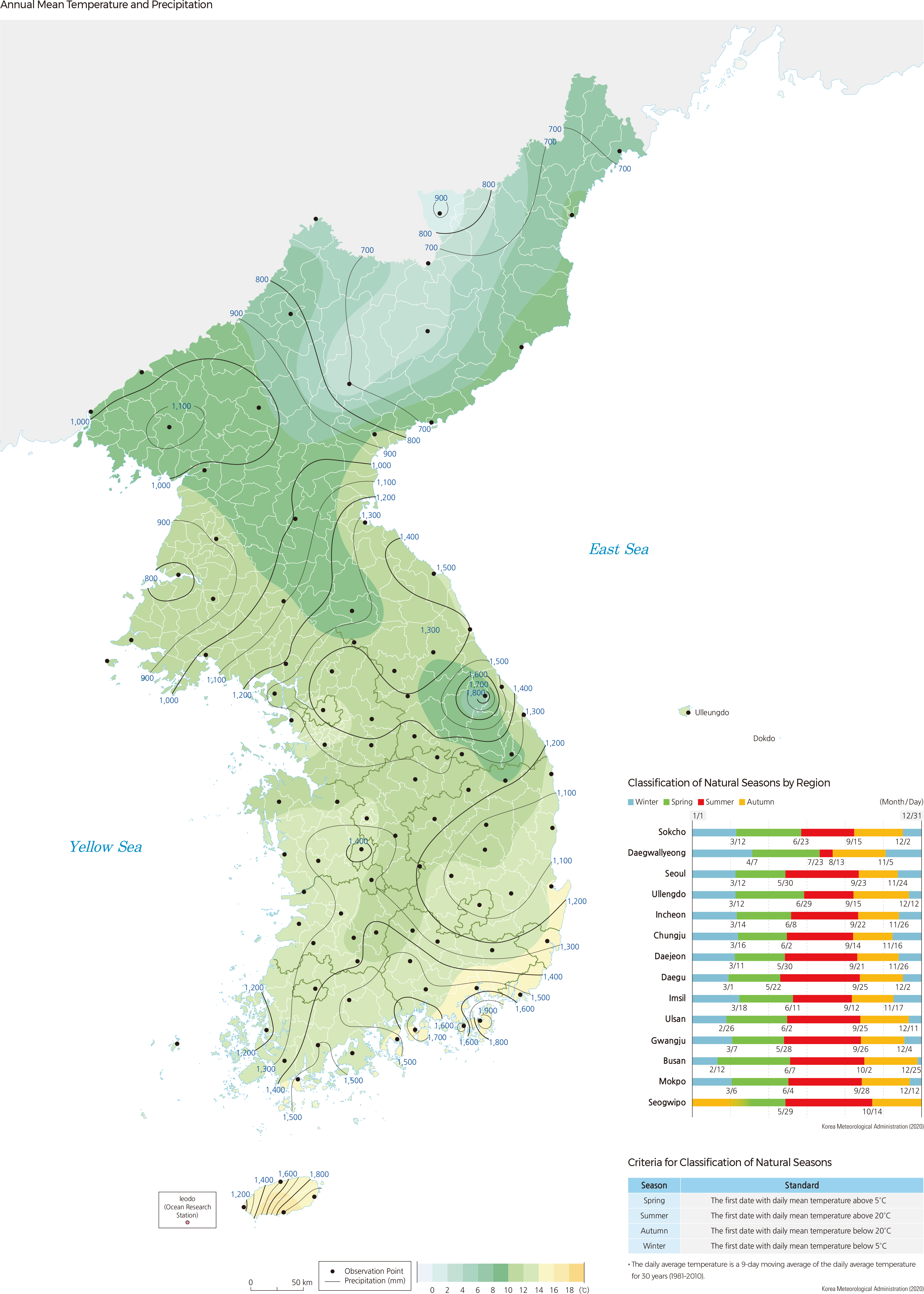English II 2020
The distribution of climates in Korea is determined by key climate factors such as latitude, elevation, geographical location, land/sea heating properties, ocean currents, the East Asian Monsoon system, and air masses. During the summer, it is hot and humid, but during the winter, it is cold and dry in response to the East Asian Monsoon.
Due to its north-south orientation and length, the Korean Peninsula experiences distinct differences in temperature as well as length of daylight and amount of solar energy received between its northern and southern points. The difference in annual mean temperature between Seogwipo (16.6˚C), located at the southernmost tip of South Korea (33˚ 14' N), and Cheorwon (10.2˚C), located at the northernmost tip (38˚ 08' N) of South Korea, demonstrates a wide variation in temperature with latitude.
Climate features vary greatly depending on elevation. The annual mean temperature at Daegwallyeong (773 m), the highest located observation station in South Korea, is 6.6˚C, which is 3.7˚C lower than that at Hongcheon (10.3˚C), which is at 141 m and located at a similar latitude. The difference in the mean temperature is also found in the southern area between Imsil (248 m) and Jeongeup (45m), with 11.2˚C and 13.1˚C, respectively.
The geographical location also makes a difference in the climate. The Taebaeksanmaek acts as a barrier to the flow of air and brings a marked difference in climate between the Yeongseo area (windward side) and Yeongdong area (leeward side). When a cold northwesterly wind dominates over the Korean Peninsula during the winter, the temperature at Chuncheon, located in the Yeongseo area, is low. Whereas in Sokcho, located in the Yeongdong area, the temperature increases. The average temperature for the warmest month, August, in Chuncheon (24.6˚C) is higher than that in Sokcho (23.7˚C), while the average temperature for the coldest month, January, in Chuncheon (-4.6˚C) is much lower than that in Sokcho (-0.3˚C). However, as a northeasterly wind blows over the Taebaeksanmaek, Chuncheon becomes warmer while Sokcho becomes colder. Also, when the northeasterly wind crosses the East Sea with its warm current flows and is forced to rise over the mountain barrier, heavy snow occasionally falls in the Yeongdong area as a result.
Korea is largely characterized by a continental climate due to the effects of the Eurasian continent. However, the climate of the coastal areas, which is mostly governed by the ocean, differs from that of the inland areas. The annual mean temperature range for Daejeon is only 0.3˚C greater than that of Boryeong, which is adjacent to the coast. The average temperature during the summer (months of June, July, and August) in Daejeon is approximately 1.3˚C higher than that in Boryeong.
The following ocean currents also affect the climate of Korea: the East Korean Warm Current and North Korean Cold Current in the East Sea, and the Yellow Sea Warm Current in the Yellow Sea. The East Korean Warm Current, diverging from the Tsushima Current at the eastern end of the Korea Strait, flows along the eastern coast of Korea and provides warm ocean water up to the latitude of 37˚–38˚ N. Part of the current flows north up to the coast of Goseong, Gangwon-do, and affects the climate of the surrounding area. The North Korean Cold Current, a part of the Primorye (Liman) Cold Current flowing from the Sea of Okhotsk, flows southward along the coast of Hamgyeong-do and reaches down to the southern region of Gangwon-do during the winter. The Yellow Sea Warm Current, a tributary of the Tsushima Current, flows from the western waters of Jejudo to the southern part of the Yellow Sea and occasionally exerts influence on the climate of the west coast.
The northward movement of the Yellow Sea Warm Current weakens during the winter, while the inflow becomes stronger during the summer. The Asian monsoon system over East Asia (including Korea, China, and Japan) is formed due to the land-sea distribution and the associated difference in heating properties. While cold, dry wind blows into the Korean Peninsula in the winter due to the continental effect, hot and humid wind blows into Korea during the summer due to the effect of the North Pacific. The climate of Korea is also under the influence of various air masses such as the Siberian air mass, the North Pacific air mass, the Okhotsk Sea air mass, and the equatorial air mass.
The classification of natural seasons based on the criteria of daily mean temperature results in regional differences in beginning date and number of days for each season. Except for Seogwipo, spring comes the earliest in Busan (February 12), while it comes the latest in Daegwallyeong (April 7). Except for Daegwallyeong (July 23), Ulleungdo (June 29), and Sokcho (June 23), summer mostly begins between late May and early June, lasting about 90–120 days. Except for Daegwallyeong (August 13), autumn starts around the middle of September, with a shorter duration (60–90 days) than spring and summer. Winter generally commences around late November, lasting about 50–150 days. |
